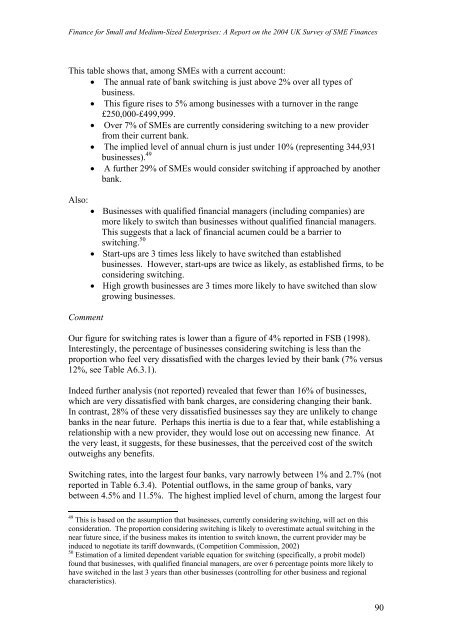Finance for Small and Medium-Sized Enterprises - DTI Home Page
Finance for Small and Medium-Sized Enterprises - DTI Home Page
Finance for Small and Medium-Sized Enterprises - DTI Home Page
You also want an ePaper? Increase the reach of your titles
YUMPU automatically turns print PDFs into web optimized ePapers that Google loves.
<strong>Finance</strong> <strong>for</strong> <strong>Small</strong> <strong>and</strong> <strong>Medium</strong>-<strong>Sized</strong> <strong>Enterprises</strong>: A Report on the 2004 UK Survey of SME <strong>Finance</strong>s<br />
This tabl s with a current account:<br />
• This figure rises to 5% among businesses with a turnover in the range<br />
£250,000-£499,999.<br />
• Over 7% of SMEs are currently considering switching to a new provider<br />
from their current bank.<br />
• The implied level of annual churn is just under 10% (representing 344,931<br />
businesses). 49<br />
e shows that, among SME<br />
• The annual rate of bank switching is just above 2% over all types of<br />
business.<br />
• A further 29% of SMEs would consider switching if approached by another<br />
bank.<br />
Also:<br />
Comment<br />
• Businesses with qualified financial managers (including companies) are<br />
more likely to switch than businesses without qualified financial managers.<br />
This suggests that a lack of financial acumen could be a barrier to<br />
switching. 50<br />
• Start-ups are 3 times less likely to have switched than established<br />
businesses. However, start-ups are twice as likely, as established firms, to be<br />
considering switching.<br />
• High growth businesses are 3 times more likely to have switched than slow<br />
growing businesses.<br />
Our figure <strong>for</strong> switching rates is lower than a figure of 4% reported in FSB (1998).<br />
Interestingly, the percentage of businesses considering switching is less than the<br />
proportion who feel very dissatisfied with the charges levied by their bank (7% versus<br />
12%, see Table A6.3.1).<br />
Indeed further analysis (not reported) revealed that fewer than 16% of businesses,<br />
which are very dissatisfied with bank charges, are considering changing their bank.<br />
In contrast, 28% of these very dissatisfied businesses say they are unlikely to change<br />
banks in the near future. Perhaps this inertia is due to a fear that, while establishing a<br />
relationship with a new provider, they would lose out on accessing new finance. At<br />
the very least, it suggests, <strong>for</strong> these businesses, that the perceived cost of the switch<br />
outweighs any benefits.<br />
Switching rates, into the largest four banks, vary narrowly between 1% <strong>and</strong> 2.7% (not<br />
reported in Table 6.3.4). Potential outflows, in the same group of banks, vary<br />
between 4.5% <strong>and</strong> 11.5%. The highest implied level of churn, among the largest four<br />
49 This is based on the assumption that businesses, currently considering switching, will act on this<br />
consideration. The proportion considering switching is likely to overestimate actual switching in the<br />
near future since, if the business makes its intention to switch known, the current provider may be<br />
induced to negotiate its tariff downwards, (Competition Commission, 2002)<br />
50 Estimation of a limited dependent variable equation <strong>for</strong> switching (specifically, a probit model)<br />
found that businesses, with qualified financial managers, are over 6 percentage points more likely to<br />
have switched in the last 3 years than other businesses (controlling <strong>for</strong> other business <strong>and</strong> regional<br />
characteristics).<br />
90















![Joint Report on Social Protection and Social Inclusion [2005]](https://img.yumpu.com/19580638/1/190x132/joint-report-on-social-protection-and-social-inclusion-2005.jpg?quality=85)
